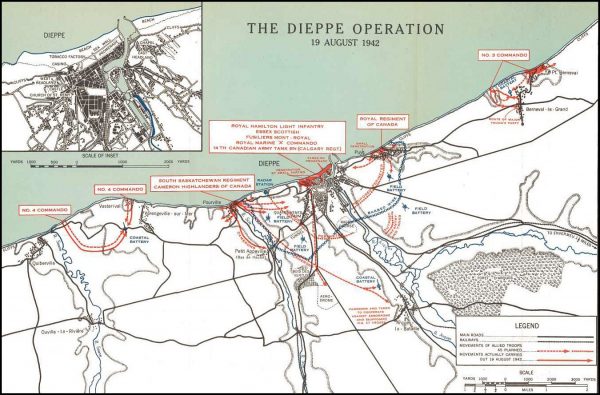TOUR UPDATE: We are honoured that Canada’s pre-eminent Dieppe Historian and Author, Prof. David O’Keefe is joining the tour as the guide for the Dieppe leg of the tour. For those unfamiliar with David’s stellar curriculum vitae, please click this link – https://en.wikipedia.org/wiki/David_O%27Keefe_(historian).
11 Days –75th Anniversary of Operation Jubilee, Vimy Ridge 100, Juno Beach August 2017
Join us for this memorable once in a lifetime tour. You will be present in Dieppe on August 19, 2017 to partake in the 75th anniversary commemorations. We will then travel onward to visit the landing beaches of Normandy – Juno & Sword. We end our ‘Maple Leaf Route’ tour with a visit to the Falaise Pocket. Then onward to the battlefields of WWI, where we will will tour Ypres, Passchendaele, Vimy Ridge, Newfoundland Park, Thiepval, attendance at Last Post ceremony at Menin Gate and much more.

The attack upon Dieppe took place on August 19, 1942. The troops involved totalled 6,100 of whom roughly 5,000 were Canadians, the remainder being British Commandos and 50 American Rangers. They had received extensive commando-type training earlier in the summer, when the first attempt had been cancelled at the last minute because of bad weather. The raid was supported by eight Allied destroyers and 74 Allied air squadrons (eight belonging to the Royal Canadian Air Force, RCAF).
The plan called for attacks at five different points on a front of roughly 16 kilometres. Canadian forces would launch simultaneous flank attacks just before dawn on the cliffs east and west of the port at Pourville (Green Beach) and Puys (Blue Beach), followed half an hour later by the main attack on the town of Dieppe (Red & White Beaches) itself. British commandos were assigned to destroy the coastal batteries at Berneval (Yellow Beach) on the eastern flank, and at Varengeville (Orange Beach) in the west.
Success depended on surprise and darkness, neither of which prevailed, due to a series of mishaps. At Puys (Blue Beach), on the eastern flank, the Royal Regiment of Canada met violent and accurate machine gun fire, from the fully-alerted German soldiers. Only 33 men out of the more than 500 who came ashore there made it back to England. The troops, together with three platoons of reinforcements from the Black Watch (Royal Highland Regiment) of Canada, were pinned on the beach by mortar and machine-gun fire, and were later forced to surrender. Evacuation was impossible in the face of German fire. Of those who landed, 200 were killed and 20 died later of their wounds; the rest were taken prisoner — the heaviest toll suffered by a Canadian battalion in a single day throughout the entire war. Failure to clear the eastern headland enabled the Germans to enfilade the Dieppe beaches and nullify the main frontal attack.
At Pourville (Green Beach), on the western flank, the South Saskatchewan Regiment and Queen’s Own Cameron Highlanders of Canada also met stiff resistance and were forced to halt. A Victoria Cross was awarded to the Commanding Officer Lt. Col. Cec Merritt, of the South Sasks, for his self sacrificing bravery while organizing the defence of the beach to allow the evacuation of his men.
The main attack was to be made across the pebble beach in front of Dieppe. German soldiers, concealed in cliff top positions and in buildings overlooking the promenade, waited. As the men of the Essex Scottish Regiment assaulted the open eastern section, the enemy swept the beach with machine-gun fire, from the German Bunkers and positions set into the cliff at the eastern-most point of the landing zones, Yellow beach. The ships transporting the men of No. 3 Commando had run into the tail end of a German convoy on the way in and several of their crafts had already been sunk. Only 18 men of this assault force made it in to engage the enemy.
All attempts to breach the seawall were beaten back with grievous loss. When one small party managed to infiltrate the town, a misleading message was received aboard the headquarters ship, which suggested that the Essex Scottish were making headway. Thus, the reserve battalion Les Fusiliers Mont Royal was sent in. They, like their comrades who had landed earlier, found themselves pinned down on the beach and exposed to intense enemy fire.
The Royal Hamilton Light Infantry landed at the west end of the promenade opposite a large isolated casino. They were able to clear this strongly-held building and the nearby pillboxes and some men of the battalion got across the bullet-swept boulevard and into the town, where they were engaged in vicious street fighting.
Misfortune also attended the landing of the tanks of the Calgary Regiment. Timed to follow an air and naval bombardment, they were put ashore ten to fifteen minutes late, thus leaving the infantry without support during the first critical minutes of the attack. Then as the tanks came ashore, they met an inferno of fire and were brought to a halt, stopped not only by enemy guns, but also immobilized by the shingle banks and seawall. Those that negotiated the seawall found their way blocked by concrete obstacles, which sealed off the narrow streets. Nevertheless, the immobilized tanks continued to fight, supporting the infantry and contributing greatly to the withdrawal of many of them; the tank crews became prisoners or died in battle. None of the 29 tanks put ashore made it off the sea-front and the soldiers not much further.
The last troops to land were part of the Royal Marine “A” Commando, who shared the terrible fate of the Canadians. They suffered heavy losses without being able to accomplish their mission.
Orange Beach, the most westerly of the beaches, is where No. 4 Commando under Lord Lovat came ashore and carried out what was probably the only successful assault of the Dieppe Raid where the Gun batteries of Varengeville were captured and their guns destroyed before the Commando’s withdrew, suffering only 45 casualties in all.
The raid also produced the most tremendous air battle of the war. While the Allied air forces were able to provide protection from the Luftwaffe for the ships off Dieppe, the cost was high. The Royal Air Force lost 106 aircraft, which was to be the highest ever single-day total The RCAF loss was 13 aircraft.
By early afternoon, Operation Jubilee was over. Conflicting assessments of the value of the raid continue to be presented. Some claim that it was a useless slaughter; others maintain that it was necessary to the successful invasion of the continent two years later on D-Day. Out of it came improvements in technique, fire support and tactics, which reduced D-Day casualties to an unexpected minimum. The men who perished at Dieppe were instrumental in saving countless lives on June 6, 1944. While there can be no doubt that valuable lessons were learned, a frightful price was paid in those morning hours of August 19, 1942. Of the 4,963 Canadians who embarked for the operation only 2,210 returned to England, and many of these were wounded. There were 3,367 casualties, including 1,946 prisoners of war; 907 Canadians lost their lives.
The German Army’s losses at Dieppe, though not inconsiderable, were much smaller than our own. The High Command communiqué issued after the action admitted 591 casualties suffered by all three services. Figures in German reports now in our hands vary from this in detail but not in the broad picture they present. The 302nd Division reported the Army losses as five officers and 116 other ranks killed, six officers and 195 other ranks wounded, and 11 other ranks missing.
Two Canadians won the Victoria Cross for actions at Dieppe: Lt. Colonel “Cec” Merritt of the South Saskatchewan Regiment and Hon. Captain John Foote of the Royal Hamilton Light Infantry.
ITINERARY
Day 1 – August 15: The coach will pick you up at Paris Charles de Gaulle airport and travel to Bayeux, Normandy for a three night stay.
Day 2 – August 16 – D-Day: We visit Pegasus Bridge, the scene of the first actions of D-Day, where Airborne troops stormed the position from gliders and held on until the linkup with ground forces from Sword Beach was made. At Juno Beach we visit the Juno Beach Centre which explains the story of the Canadian role in the Battle of Normandy.
Day 3 – August 17: Continue on our ‘Maple Leaf Route’ ending at The Falaise Gap – After lunch we visit to the Falaise Pocket and a short walk along the ‘Corridor of Death’, used by the Germans to make their retreat in August 1944. For a complete itinerary, please see our 2 day tour here; http://www.canadianbattlefieldtours.ca/battle-of-normandy/
Day 4 – August 18: Leave Bayeux for Dieppe after breakfast. Free afternoon in Dieppe
Day 5 – August 19: 75th Anniversary of Operation Jubilee – We attend the ceremonies at Dieppe on 19 August 2017.
Day 6 – August 20: Full Day on the Dieppe Battlefields.
Day 7 – August 21: Leave hotel after breakfast and travel to Arras area for a three nights stay. In the afternoon we visit Vimy Ridge Memorial and the information centre.
Day 8 – August 22: Canada in Flanders: Today we proceed to the battlefields around Ypres looking at where the Canadian Expeditionary Force (CEF) fought 1915-1917. We see where Canadian troops first faced gas at St Julien, look at the battle of the craters at St Eloi, visit the Canadian trenches at Sanctuary Wood and examine the costly battle of Passchendaele. We also attend the Last Post at the Menin Gate.
Day 9 – August 23: Canada on the Somme 1916: We visit the Somme battlefields today to look at the first CEF attack of the war at Courcelette, seeing the cemeteries and memorial, the new museum at Thiepval, and also the trenches of the Newfoundland Park.
Day 10 – August 24: We travel to Paris where you can spend the rest of the day free to enjoy this beautiful capital then transfer to your hotel in the Paris area for a one night stay on Bed and Breakfast basis.
Day 11 – August 25: Transfer to Paris Charles de Gaulle Airport for your flight back to Canada
PRICING
$3900.00 CAD Land Only, based on Double Occupancy
$585.00 CAD Single Supplement (limited spaces available)
$800.00 Non-Refundable Deposit due at time of booking
What’s Included:
- Services of experienced drivers/coach assistants, in top of the line vehicle
- Hotel accommodation as specified above, 10 Nights on a Bed and Breakfast basis
- Entrances to Thiepval Museum, Vimy Museum, Lens 1418 Museum, Juno Beach Centre
- Included itinerary as specified above
- Specialist Battlefield Guide
What’s Not Included:
- Other meals i.e. Lunches & Dinners.
- Entrances to museums & places of interest other than mentioned above
- Gratuities to your drivers/coach assistants
- Flights from Canada to France
- Travel Insurance – Strongly recommended
Please see our TERMS & CONDITIONS.
All booking inquiries should be made to [email protected].





